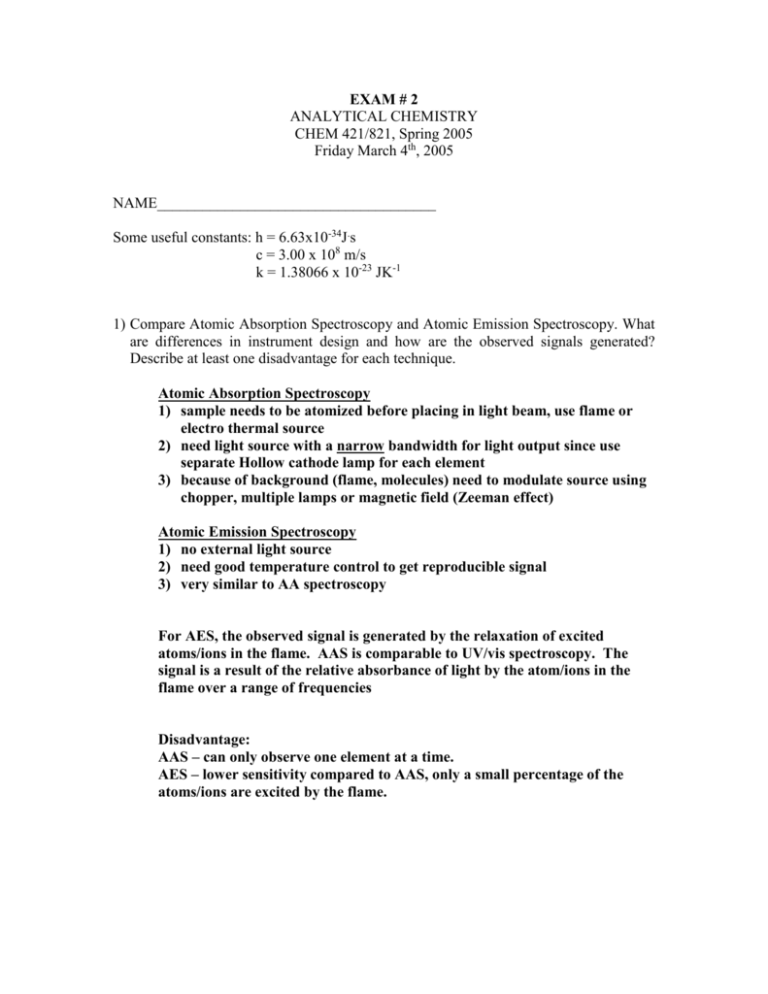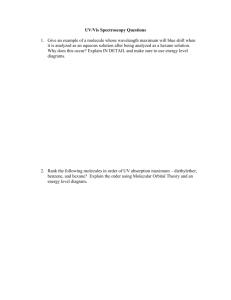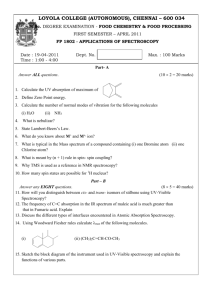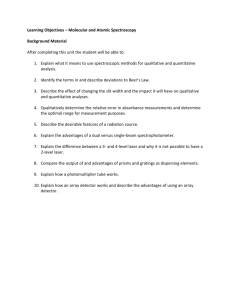EXAM # 1 - UNL | Powers Group
advertisement

EXAM # 2 ANALYTICAL CHEMISTRY CHEM 421/821, Spring 2005 Friday March 4th, 2005 NAME_____________________________________ Some useful constants: h = 6.63x10-34J.s c = 3.00 x 108 m/s k = 1.38066 x 10-23 JK-1 1) Compare Atomic Absorption Spectroscopy and Atomic Emission Spectroscopy. What are differences in instrument design and how are the observed signals generated? Describe at least one disadvantage for each technique. Atomic Absorption Spectroscopy 1) sample needs to be atomized before placing in light beam, use flame or electro thermal source 2) need light source with a narrow bandwidth for light output since use separate Hollow cathode lamp for each element 3) because of background (flame, molecules) need to modulate source using chopper, multiple lamps or magnetic field (Zeeman effect) Atomic Emission Spectroscopy 1) no external light source 2) need good temperature control to get reproducible signal 3) very similar to AA spectroscopy For AES, the observed signal is generated by the relaxation of excited atoms/ions in the flame. AAS is comparable to UV/vis spectroscopy. The signal is a result of the relative absorbance of light by the atom/ions in the flame over a range of frequencies Disadvantage: AAS – can only observe one element at a time. AES – lower sensitivity compared to AAS, only a small percentage of the atoms/ions are excited by the flame. 2) (a) What is a fundamental difference between IR detectors and UV/vis detectors? In general, UV/vis detectors convert a photon of light into an induced current. Conversely, IR detectors use the temperature dependence of resistance of metals to measure a change in temperature as a result of a change in current/potential. (b) Explain the operation of one type of IR detector. Thermocouple – two pieces of dissimilar metals fused together at the ends when heated, metals heat at different rates. A potential difference is created between two metals that varies with their difference in temperature h metal1 metal2 - + V IR transparent material (NaCl) 3) Match the Structures with the IR Spectra. Label key absorbance on the spectra consistent with the assigned structure. OH (b) (a) (3) (c) OH O-H C=C-H C=C-H C=O C=C C=C N-HC-H (2) C=C-H N-H C=C C=O (3) O-H (2) NH3 (1) (1) O C=C 4) The harmonic oscillator model is a good approximation of atomic stretching. (a) Use an energy level diagram to explain typical vibration absorbance observed IR spectroscopy. (b) Indicate region(s) in the energy diagram where the harmonic oscillator model fails. What are the sources of these deviations from the harmonic oscillator model (c) Indicate where rotational vibrations occurs on this diagram. (a) (b) deviation from the harmonic oscillator model occurs at very large or small interatomic distances. At large, interatomic differences dissociation occurs, where at short interatomic distances nuclear repulsion becomes a factor. (c) rotational transitions Potential Energy (E) Vibrational transitions Interatomic Distance (r) 5) The IR spectrum for acetylene (C2H2) contains a strong absorbance at 3423 cm-1, but the Raman spectrum contains absorbance at 3476 cm-1 and 2181 cm-1. (a) What are the number of vibrational modes for acetylene. (b) Explain, in detail, the source of the differences in the IR and Raman spectra. (a) For linear molecules, number of types of vibrations: 3N-5 = 3(4) – 5 = 7 (b) H-C=C-H C-H symmetric stretch is Raman active (symmetry, change in polarization) and occurs at 3476 cm-1, IR inactive no change in dipole moment. H-C=C-H C-C symmetric stretch is Raman active (symmetry, change in polarization) and occurs at 2181 cm-1, IR inactive no change in dipole moment. H-C=C-H C-H asymmetric stretch is IR active because of a change in dipole moment (asymmetric) and occurs at 3423 cm-1. This stretch is Raman inactive because of no change in polarization 6) Given the following chromatogram and a column length of 20 cm: 10 min. 2 min. 5 min. Wb Calculate: (a) capacity factor for solutes A and B (b) number of theoretical plates for solutes A and B (c) plate height for solutes A and B (d) separation factor (e) how would you classify the performance of the column based on the capacity factors? (a) capacity factor k’ = (tR –tM)/tM k’(A) = (5 min)/2 min = 2.5 k’(B) = (10 min)/2 min. = 5.0 (b) N = 16 (tR/Wb)2 Wb is estimated to be ~ 2 min N(A) = 16(7 min/2 min)2 N(A) = 196 N(B) = 16(12 min/2 min)2 N(A) = 576 (c) H = L/N H(A) = 20 cm/196 = 0.10 cm H(B) = 20 cm/576 = 0.035 cm (d) = k’A/k’B A = 5.0/2.5 = 2 (e) the capacity factors 2.5 & 5.0 are consistent with optimum performance 6) A number of factors contribute to experimental peak shapes. Describe one factor that contributes to line-shapes in (a) AES and (b) liquid chromatography. (c) What factor that contributes to broad lines in UV/vis is no longer present in either AAS or AES? (a) Doppler effect – atoms/ions are randomly moving towards/away from the detector resulting in an apparent compression/expansion of the wavelength for each atom/ions. This results peak broadening. Other possible answers (b) Eddy diffusion – analyte molecules can experience difference paths and as a result different effective lengths as the analytes move through the packed column. Other possible answers. (c) AAS and AES is directed at the analysis of individual elements/ions which do not have any vibrational modes. The abundance of vibrational transitions superimposed on the electronic energy states results in the broad spectrum typical of UV/vis. 7) Deuterium lamps are problematic in Atomic Absorption Spectroscopy because they: a) provide a broad bandwidth of UV/Vis radiation b) provide rapid sample atomization c) provide a narrow bandwidth of light d) provide a source of sputtering 8) Atomic Emission Spectroscopy can analyze: a) one element or ion at a time b) molecules, ions and elements c) 40-50 elements simultaneously d) only solid samples 9) Protecting agents in atomic spectroscopy are effective because they a) lower the flame temperature b) bind to analyte, but are volatile c) form preferential compounds with interfering ions d) produce an excess of electrons 10) The Two-line method, Source Modulation method and the Zeeman effect are important in atomic absorption spectroscopy because they: a) correct for absorbance from molecular species b) correct for the background created by the flame c) allow for the measurement of a small signal against a large background d) all of the above 11) In chromatography, the capacity factor is related to: a) equilibrium constant between the mobile and stationary phase b) column length c) flow rate d) all of the above 12) A laser is typically used for Raman spectroscopy because: a) low intensity of the stokes and anti-stokes transitions b) requires a visible light source c) vibrational transitions have a large E d) monochromators used for Raman spectroscopy absorb IR 13) Raman Spectroscopy: a) is directly complimentary to Atomic Absorbance Spectroscopy. b) provides information about the functional groups present in a molecule c) requires a change in dipole-moment of a bond vibration for an observed transition. d) frequency shifts are related to electronic changes in the molecule 14) In FTIR: a) S/N is proportional to the number of scans b) requires absorbance to observed by sequentially scanning through IR bandwidth c) both the sensitivity and resolution are increased compared to traditional IR d) FTIR is much slower than traditional IR 15) A primary difference between UV/vis spectroscopy and Atomic Absorption spectroscopy is: a) analytes must be aqueous soluble for UV/vis spectroscopy b) AAS uses a hollow cathode lamp that emits IR radiation c) a deuterium lamp is never used in AAS d) the sample is atomized in AAS prior to measuring an absorbance





